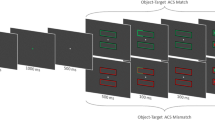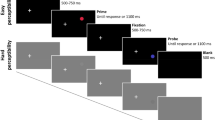Abstract
Recent studies have documented that the hand’s ability to perform actions affects the visual processing and attention for objects near the hand, suggesting that actions may have specific effects on visual orienting. However, most research on the relation between spatial attention and action focuses on actions as responses to visual attention manipulations. The current study examines visual attention immediately following an executed or imagined action. A modified spatial cuing paradigm tested whether a brief, lateralized hand-pinch performed by a visually hidden hand near the target location, facilitated or inhibited subsequent visual target detection. Conditions in which hand-pinches were fully executed (action) were compared to ones with no hand-pinch (inaction) in Experiment 1 and imagined pinches (imagine) in Experiment 2. Results from Experiment 1 indicated that performed hand pinches facilitated rather than inhibited subsequent detection responses to targets appearing near the pinch, but target detection was not affected by inaction. In Experiment 2, both action and imagined action conditions cued attention and facilitated responses, but along differing time courses. These results highlight the ongoing nature of visual attention and demonstrate how it is deployed to locations even following actions.




Similar content being viewed by others
References
Abrams RA, Davoli CC, Du F, Knapp WH, Paull D (2008) Altered vision near the hands. Cognition 107:1035–1047
Berthoz A (1991) Brain mechanisms in the perception and control of movement. In: Orban GA, Wolf S, Hillsdale NJ (eds) Cognitive neuroscience: research directions in cognitive neuroscience: European perspectives, vol 4. Lawrence Erlbaum Associates, Inc, England, pp 43–71
Christensen A, Ilg W, Giese MA (2011) Spatiotemporal tuning of the facilitation of biological motion perception by concurrent motor execution. J Neurosci 31:3493–3499
Cosman JD, Vecera SP (2010) Attention affects visual perceptual processing near the hand. Psychol Sci 21:1254–1258
Cousineau D (2005) Confidence intervals in within-subjects designs: a simpler solution to Loftus and Masson’s method. Tutor Quant Methods Psychol 1:42–45
Decety J (1996) Do imagined and executed actions share the same neural substrate? Cogn Brain Res 3:87–93
Desimone R, Duncan J (1995) Neural mechanisms of selective visual attention. Annu Rev Neurosci 18:193–222
Deubel H, Schneider WX, Paprotta (1998) Selective dorsal and ventral processing: evidence for a common attentional mechanism in reaching and perception. Vis Cogn 5:81–107
Duncan J (2006) Brain mechanisms of attention. Q J Exp Psychol 59:2–27
Faul F, Erdfelder E, Lang A-G, Buchner A (2007) G*Power 3: a flexible statistical power analysis program for the social, behavioral, and biomedical sciences. Behav Res Methods 39:175–191
Frak V, Paulignan Y, Jeannerod M (2001) Orientation of the opposition axis in mentally simulated grasping. Exp Brain Res 136:120–127
Garza J, Strom M, Wright CE, Roberts R, Reed CL (2013) Top-down influences mediate hand bias in spatial attention. Atten Percept Psychophys 75:819–823
Gherri E, Eimer M (2010) Manual response preparation disrupts spatial attention: an electrophysiological investigation of links between action and attention. Neuropsychologia 48:961–969
Grubb JD, Reed CL (2002) Trunk Orientation induces neglect-like lateral biases in covert attention. Psychol Sci 13:553–556
Grubb J, Reed CL, Bate S, Garza JP, Roberts RJ Jr (2008) Walking reveals trunk orientation bias for visual attention. Percept Psychophys 70:688–696
Herwig A (2015) Linking perception and action by structure or process? Toward an integrative perspective. Neurosci Behav Rev 52:105–116
Hommel B (2004) Event files: feature binding in and across perception and across. Trends Cogn Sci 8:494–500
Hommel B, Müsseler J, Aschersleben G, Prinz W (2001) The theory of event coding (TEC): a framework for perception and action planning. Behav Brain Sci 24:849–878
Howard LA, Tipper SP (1997) Hand deviations away from visual cues: indirect evidence for inhibition. Exp Brain Res 113:144–152
Jeannerod M (1995) Mental imagery in the motor cortex. Neuropsychologia 33:1419–1432
Kennett S, Spence C, Driver J (2002) Visuo-tactile links in covert exogenous spatial attention remap across changes in unseen hand posture. Percept Psychophys 64:1083–1094
Klein RM (2000) Inhibition of return. Trends Cogn Sci 4(4):138–147
Luck SJ, Vecera SP (2002) Attention. In: Pashler H, Yantis S (eds) Steven’s handbook of experimental psychology, vol 1 sensation and perception, 3rd edn. Wiley, New York, pp 235–286
MacKay DG (1987) The organization of perception and action: a theory for language and other cognitive skills. Springer, Berlin, p 255
Posner MI, Cohen Y (1984). Components of visual orienting. In Bouma H, Bowhuis D (eds) Attention and performance X. Hillsdale, Erlbaum, pp 531–556
Posner MI, Rafal RD, Choate LS, Vaughan J (1985) Inhibition of return: neural basis and function. Cogn Neuropsychol 2:211–228
Pratt J, Abrams RA (1994) Action-centered inhibition: effects of distractors on movement planning and execution. Hum Mov Sci 13:245–254
Prinz W (1997) Perception and action planning. Eur J Cogn Psychol 9:129–154
Reed CL (2002) Chronometric comparisons of imagery to action: visualizing vs. physically performing springboard dives. Mem Cogn 30:1169–1178
Reed CL, Grubb JD, Steele C (2006) Hands up: attentional prioritization of space near the hand. J Exp Psychol Hum Percept Perform 32:166–177
Reed CL, Betz R, Garza J, Roberts R (2010) Grab it! Biased attention in functional hand and tool space. Atten Percept Psychophys 72:236–245
Ristic J, Wright A, Kingstone A (2007) Attentional control and reflexive orienting to gaze and arrow cues. Psychon Bull Rev 14:964–969
Rizzolatti G, Riggio L, Dascola I, Umiltá C (1987) Reorienting attention across the horizontal and vertical meridians: evidence in favor of a premotor theory of attention. Neuropsychologia 25:31–40
Schiegg A, Deubel H, Schneider WX (2003) Attentional selection during preparation of prehension movements. Vis Cogn 10:409–431
Spence C, Pavani F, Driver J (2000) Crossmodal links between vision and touch in covert endogenous spatial attention. J Exp Psychol Hum Percept Perform 26(4):1298–1319
Taylor TL, Klein RM (1998) On the causes and effects of inhibition of return. Psychon Bull Rev 5(4):625–643
Thomas LE (2015) Grasp posture alters visual processing biases near the hands. Psychol Sci 26:625–632
Tipper SP (1992) Selection for action: the role of inhibitory mechanisms. Curr Dir Psychol Sci 1:105–109
Tipper SP, Howard LA, Houghton G (1999) Action-based mechanisms of attention. In: Humphreys GW, Duncan J, Treisman A (eds) Attention, space, and action: studies in cognitive neuroscience. Oxford University Press, New York, pp 232–247
Treisman A (2004) Psychological issues in selective attention. In: The cognitive neurosciences, 3rd edn. MIT, Cambridge, pp 529–544
Author information
Authors and Affiliations
Corresponding author
Rights and permissions
About this article
Cite this article
Garza, J.P., Reed, C.L. & Roberts, R.J. Attention orienting near the hand following performed and imagined actions. Exp Brain Res 236, 2603–2610 (2018). https://doi.org/10.1007/s00221-018-5307-2
Received:
Accepted:
Published:
Issue Date:
DOI: https://doi.org/10.1007/s00221-018-5307-2




